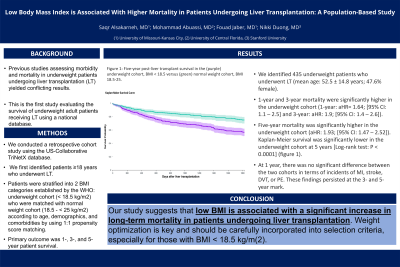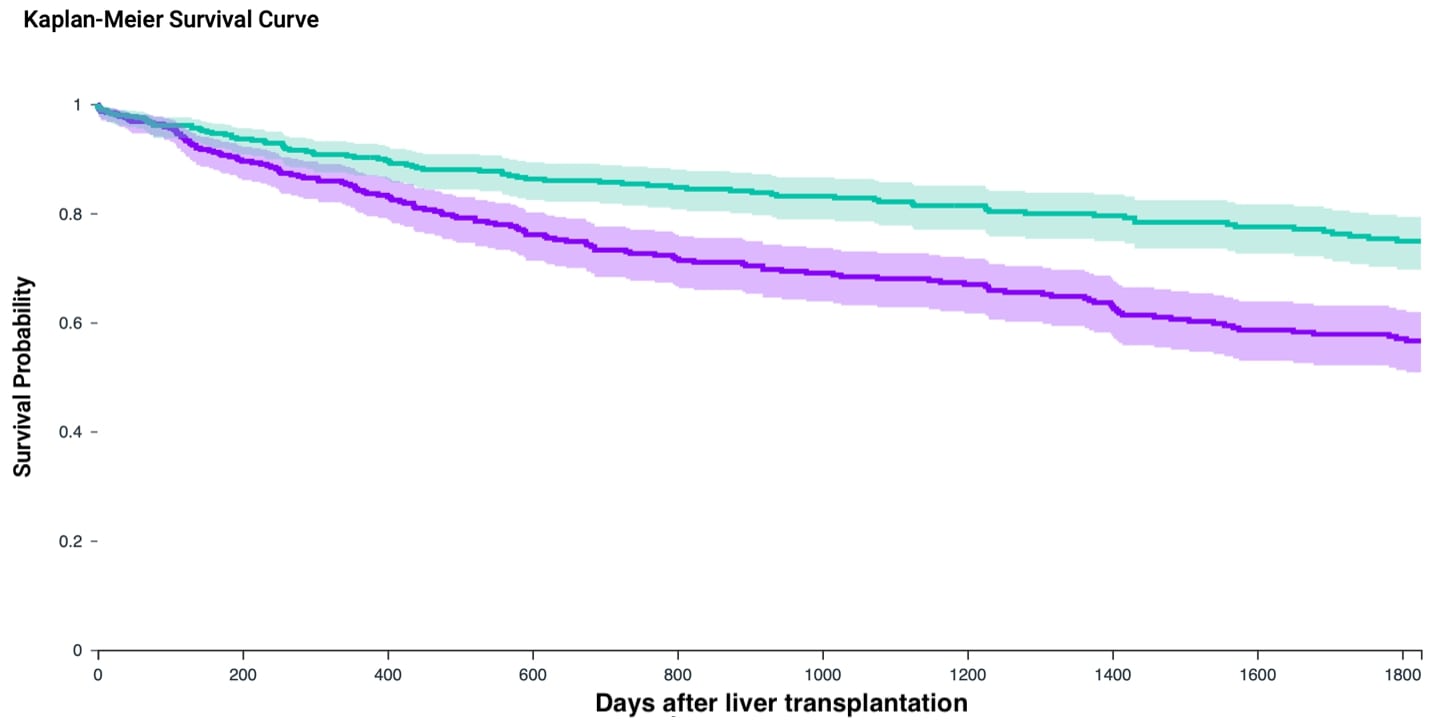Monday Poster Session
Category: Liver
P2951 - Low Body Mass Index is Associated With Higher Mortality in Patients Undergoing Liver Transplantation: A Population-Based Study
Monday, October 28, 2024
10:30 AM - 4:00 PM ET
Location: Exhibit Hall E

Has Audio
.jpg)
Saqr Alsakarneh, MD
University of Missouri - Kansas City School of Medicine
Kansas City, MO
Presenting Author(s)
Saqr Alsakarneh, MD1, Mohammad Abuassi, MD2, Fouad Jaber, MD1, Nikki Duong, MD3
1University of Missouri - Kansas City School of Medicine, Kansas City, MO; 2University of Central Florida, HCA Healthcare GME, Gainesville, FL; 3Stanford University, Kansas City, MO
Introduction: Previous studies assessing morbidity and mortality in underweight patients undergoing liver transplantation (LT) yielded conflicting results. Most of these studies had small sample sizes and were single-center studies. This is the first study evaluating the survival of underweight adult patients receiving LT using a national database.
Methods: This retrospective cohort study used the TriNetX research network to identify patients ≥18 years who underwent LT. Patients were stratified into 2 BMI categories established by the WHO: underweight cohort (< 18.5 kg/m2) who were matched with normal weight cohort (18.5 - < 25 kg/m2) according to age, demographics, and comorbidities by using 1:1 propensity score matching. Primary outcome was 1-, 3-, and 5-year patient survival. Secondary outcomes included myocardial infarction (MI), pulmonary embolism (PE), stroke, and deep venous thrombosis (DVT). Kaplan-Meier survival curves with the log-rank test and COX proportional hazard models were used to assess the effect of BMI on LT outcomes.
Results: We identified 435 underweight patients who underwent LT (mean age: 52.5 ± 14.8 years; 47.6% female). 1-year and 3-year mortality were significantly higher in the underweight cohort (1-year: aHR= 1.64; [95% CI: 1.1 – 2.5] and 3-year: aHR: 1.9; [95% CI: 1.4 – 2.6]). Five-year mortality was significantly higher in the underweight cohort (aHR: 1.93; [95% CI: 1.47 – 2.52]). Kaplan-Meier survival was significantly lower in the underweight cohort at 5 years [Log-rank test: P < 0.0001] (figure 1). At 1 year, there was no significant difference between the two cohorts in terms of incidents of MI, stroke, DVT, or PE. These findings persisted at the 3- and 5-year mark.
Discussion: This is the first study to demonstrate that low BMI is associated with a significant increase in long-term mortality in patients undergoing liver transplantation. Multi-disciplinary management with the dietician team is imperative for patients undergoing evaluation for transplant. Weight optimization is key and should be carefully incorporated into selection criteria, especially for those with BMI < 18.5 kg/m(2). Future multi-center studies are warranted to explore this association further.

Disclosures:
Saqr Alsakarneh, MD1, Mohammad Abuassi, MD2, Fouad Jaber, MD1, Nikki Duong, MD3. P2951 - Low Body Mass Index is Associated With Higher Mortality in Patients Undergoing Liver Transplantation: A Population-Based Study, ACG 2024 Annual Scientific Meeting Abstracts. Philadelphia, PA: American College of Gastroenterology.
1University of Missouri - Kansas City School of Medicine, Kansas City, MO; 2University of Central Florida, HCA Healthcare GME, Gainesville, FL; 3Stanford University, Kansas City, MO
Introduction: Previous studies assessing morbidity and mortality in underweight patients undergoing liver transplantation (LT) yielded conflicting results. Most of these studies had small sample sizes and were single-center studies. This is the first study evaluating the survival of underweight adult patients receiving LT using a national database.
Methods: This retrospective cohort study used the TriNetX research network to identify patients ≥18 years who underwent LT. Patients were stratified into 2 BMI categories established by the WHO: underweight cohort (< 18.5 kg/m2) who were matched with normal weight cohort (18.5 - < 25 kg/m2) according to age, demographics, and comorbidities by using 1:1 propensity score matching. Primary outcome was 1-, 3-, and 5-year patient survival. Secondary outcomes included myocardial infarction (MI), pulmonary embolism (PE), stroke, and deep venous thrombosis (DVT). Kaplan-Meier survival curves with the log-rank test and COX proportional hazard models were used to assess the effect of BMI on LT outcomes.
Results: We identified 435 underweight patients who underwent LT (mean age: 52.5 ± 14.8 years; 47.6% female). 1-year and 3-year mortality were significantly higher in the underweight cohort (1-year: aHR= 1.64; [95% CI: 1.1 – 2.5] and 3-year: aHR: 1.9; [95% CI: 1.4 – 2.6]). Five-year mortality was significantly higher in the underweight cohort (aHR: 1.93; [95% CI: 1.47 – 2.52]). Kaplan-Meier survival was significantly lower in the underweight cohort at 5 years [Log-rank test: P < 0.0001] (figure 1). At 1 year, there was no significant difference between the two cohorts in terms of incidents of MI, stroke, DVT, or PE. These findings persisted at the 3- and 5-year mark.
Discussion: This is the first study to demonstrate that low BMI is associated with a significant increase in long-term mortality in patients undergoing liver transplantation. Multi-disciplinary management with the dietician team is imperative for patients undergoing evaluation for transplant. Weight optimization is key and should be carefully incorporated into selection criteria, especially for those with BMI < 18.5 kg/m(2). Future multi-center studies are warranted to explore this association further.

Figure: Figure 1: Five-year post-liver transplant survival in the (purple) underweight cohort, BMI < 18.5 versus (green) normal weight cohort, BMI 18.5-25.
Disclosures:
Saqr Alsakarneh indicated no relevant financial relationships.
Mohammad Abuassi indicated no relevant financial relationships.
Fouad Jaber indicated no relevant financial relationships.
Nikki Duong indicated no relevant financial relationships.
Saqr Alsakarneh, MD1, Mohammad Abuassi, MD2, Fouad Jaber, MD1, Nikki Duong, MD3. P2951 - Low Body Mass Index is Associated With Higher Mortality in Patients Undergoing Liver Transplantation: A Population-Based Study, ACG 2024 Annual Scientific Meeting Abstracts. Philadelphia, PA: American College of Gastroenterology.
